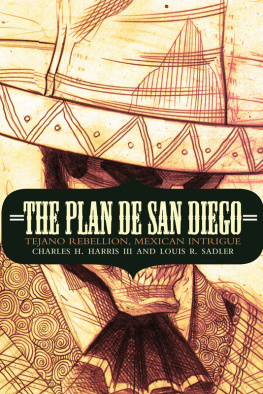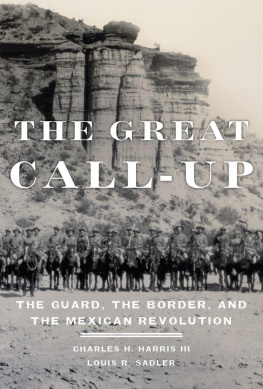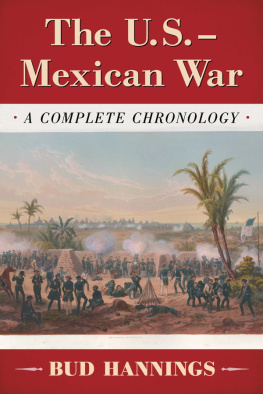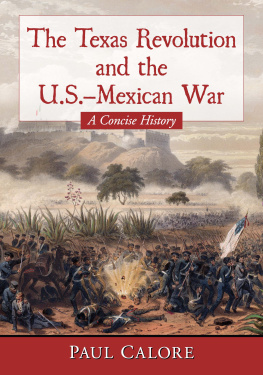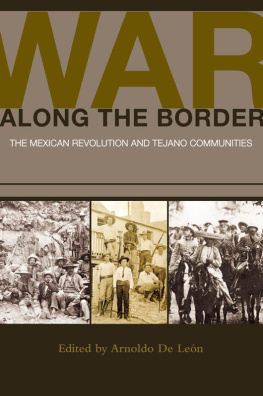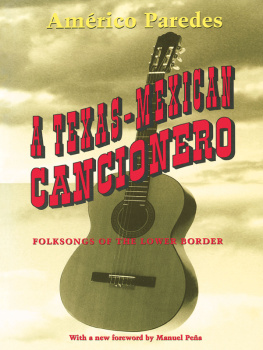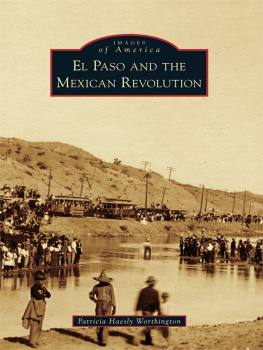The Plan de San Diego
Tejano Rebellion, Mexican Intrigue
Charles H. Harris III and Louis R. Sadler
University of Nebraska Press | Lincoln and London
The Mexican Experience | William H. Beezley, series editor
2013 by the Board of Regents of the University of Nebraska
All rights reserved
Manufactured in the United States of America
Library of Congress Cataloging-in-Publication Data
Harris, Charles H. (Charles Houston)
The Plan de San Diego: Tejano rebellion, Mexican intrigue / Charles H. Harris III and Louis R. Sadler.
pages cm. (The Mexican experience)
Includes bibliographical references and index.
ISBN 978-0-8032-6477-9 (pbk.: alk. paper)
ISBN 978-0-8032-6493-9 (electronic: epub)
ISBN 978-0-8032-6494-6 (electronic: mobi)
1. Plan de San Diego. 2. InsurrectionsTexasHistory20th century. 3. Subversive activitiesTexasHistory20th century. 4. MexicoHistoryRevolution, 19101920Diplomatic history. 5. MexicoHistoryRevolution, 19101920Social aspects. 6. Mexican AmericansTexasHistory20th century. 7. TexasRelationsMexico. 8. MexicoRelationsTexas. 9. TexasHistory, 18461950. I. Sadler, Louis R. II. Title.
F 391. H 278 2013
976.4'063dc23
2012046476
To William H. Beezley
Illustrations
Maps
Preface
There appeared in South Texas in January 1915 a most remarkable documentthe Plan de San Diego. Ostensibly written in the small town of San Diego in Duval County, it called for nothing less than a Hispanic uprising designed to achieve the independence of the Southwest as a Hispanic republic. The Plan proclaimed a genocidal war without quarter against Anglos. The most striking feature of this revolutionary manifesto was a call to kill all Anglo males over the age of sixteen. Predictably, attempts to implement the Plan produced a massive Anglo backlash, and during 191516 conditions in the lower Rio Grande valley of Texas deteriorated to the point that a race war seemed imminent. The Plan de San Diego of course had no chance of succeeding, but it left a legacy of racial animosity that endures to the present day.
The Plan and its subsequent modifications remain controversial, both because of their racial aspects and because some events are still obscure. In discussing the Plan, the first question to be addressed is whether the manifesto should even be taken seriously. Especially among Hispanics, the answer is yes, focusing on the oppression endured by Hispanics in Texas. Second, was the insurrection in fact a homegrown Tejano liberation movement? Third, was there substantial involvement from Mexico, guiding, supplying, and manipulating the insurgents? If so, were revolutionary factions or the Mexican government involved? In this connection, some historians have attributed the Plan to the followers of the anarchist Ricardo Flores Magn, others to the followers of the exiled strongman General Victoriano Huerta, still others to the regime of President Venustiano Carranza. There is particular disagreement over whether Carranza himself was involved. The main things in dispute about the Plan de San Diego are who wrote it and when, where, and why it was written. Thus, the definitive study of the Plan has yet to appear.
As far as Anglos and the authorities were concerned, the sediciosos (those engaged in sedition) were bandits. Hence, the troubles have been referred to as the Bandit War. Hispanics quickly point out that many of those involved in the Plan werent bandits. True, but then many of them werent freedom fighters either. The Plan de San Diego affair defies simplistic treatment, especially when some of the violence had nothing to do with the Plan. The manifesto provided a splendid umbrella for paying off old scores and seizing new opportunities.
There has developed a considerable literature concerning the Plan de San Diego. However, some of it has been ideologically driven, with disregard for inconvenient facts, or characterized by superficial research and glittering generalities. For instance, there has been no effort made even to determine whether the Plan was actually written in San Diego. In addition, the literature has focused on a few of the sediciosos leaders, with little or no attention to the rank and file. Heretofore, writers have emphasized the backgroundthat is, the conditions that produced the Plan. A number of works have exhaustively addressed these conditionsoppression of and discrimination against Tejanos, loss of their land, abuse by peace officers, especially the Texas Rangers, and so forth.
Our approach is significantly different. From our perspective, what is important isnt who wrote the Plan or when it was written but the use to which it was put and who benefited by that use. What hasnt been investigated is the Mexican connection, and that is our emphasis. As the United States has learned in Afghanistan, when the enemy can operate from a privileged sanctuary, in this case Pakistan, the enemy is much harder to defeat. Regarding the Plan de San Diego, had the sediciosos not enjoyed a base of operations in Mexico, the Plan would have been merely a curiosity. But those Mexicans supporting the Plan had their own agendas, and sometimes they differed considerably from the aims of the sediciosos. Unfortunately, most of those who have written about the Plan de San Diego do not understand the complexities of the Mexican Revolution. This understanding is crucial to understanding the course of the Plan conspiracy.
Our thesis is that the Plan de San Diego became an instrument of Mexican government policy. In a brilliant covert operation, President Venustiano Carranza manipulated the sedicioso insurgents as pawns in order to gain desperately needed diplomatic recognition in 1915 of his regime by the United States. That objective achieved, Carranza immediately suppressed the Plan and stopped financing it. In an unexpected development, when in 1916 Pancho Villas raid on Columbus, New Mexico, resulted in the dispatch into Chihuahua of General John J. Pershings Punitive Expedition, plunging the United States and Mexico into a confrontation, Carranza revived the Plan de San Diego in an effort to force the withdrawal of the Punitive Expedition. The result was the crisis of June 1916, in which the two countries literally came to the brink of outright war. Happily, the war crisis was defused by diplomacy; Carranza promptly shut down the Plan de San Diego once again. The sedicioso leadership hiding in Mexico had little alternative but to dance to Carranzas tune. These refugee Tejanos could only watch their movement disintegrate.
We propose to treat not only the insurrection itself but also aspects such as the subsequent careers of some of the protagonists, the continuing controversy over the number of casualties, and some of the more interesting interpretations of the Plan.
The principal United States source we utilize is the archive of the Federal Bureau of Investigation (at the time named the Bureau of Investigation), the agency most directly involved in investigating the Plan. The key files are those available since 1977 on microfilm in whats called Old Mex 232, supplemented by files the bureau has recently made available on the Web as 232-84. The bureaus archive provides almost a day-to-day picture of the troubles in South Texas. Like any other law enforcement agency, the bureau relied heavily on informants. An extremely useful source is the affidavit in the Department of States Office of the Counselor by one Juan K. Forseck, an important Carranza agent who had intimate knowledge of the conspiracy. Supplementing these sources are federal court cases, the Texas Ranger archive, the State Departments Matamoros post records, and the U.S. Armys reports.
As for Mexican sources, there is the multivolume Documentos Histricos de la Revolucin Mexicana
Next page
